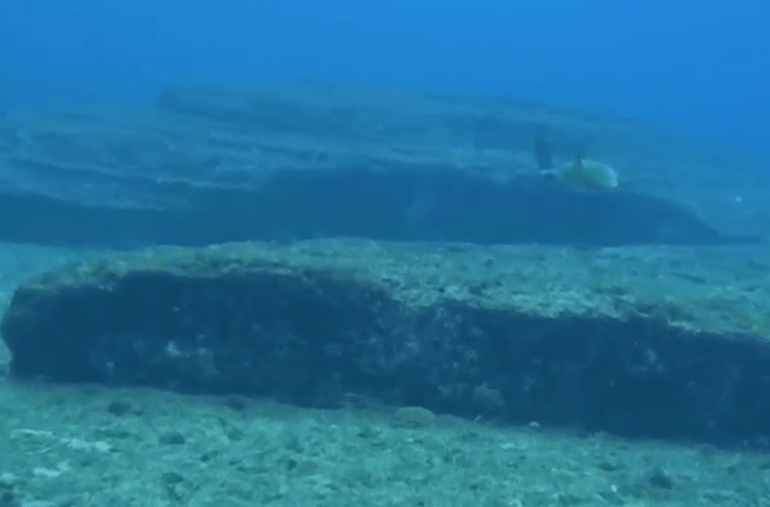A DIVER has discovered a series of mysterious “pyramids” on the ocean floor, dubbing it the “real life Atlantis”.
The hidden gem was undiscovered until a local diver, Kihachiro Aratake, made the stunning discovery.
BBC GlobalA diver in Japan discovered a series of underwater structure off the coast of Japan[/caption]
BBC GlobalThe hidden gem laid undiscovered until 1987[/caption]
BBC GlobalKihachiro Aratake said he was emotion when he first came across the structure[/caption]
Aratake was diving off the coast of Yonaguni Island in Japan when he spotted the towering underwater pyramids.
Speaking to BBC Global, he said: “I was very emotional when I found it.
“I realised that this would become a treasure of Yonaguni Island. I kept it a secret.
“I didn’t tell anyone on my staff.”
Also known as the Yonaguni Monument, one of the formations has been nicknamed the ‘Atlantis’ due to its size and structure.
The stunning underwater formation is 164ft long and 65ft wide and features spiralling steps and flat surfaces.
The mysterious underwater structure has baffled locals, with some believing the pyramids were the remains of a lost civilisation.
However, not everyone is convinced that the monument was man-made or if it was a natural formation shaped by the ocean currents.
Scientists currently believe the monument is thousands of years old, and have questioned whether humans would have been able to make such impressive formations so long ago.
A group of scientists led by Masaaki Kimura from Ryukyu University began researching the mysterious rock formations after the discovery was made in 1987.
The research scientist said there was vast evidence of man’s influence on the structures.
Professor Kimura said: “I think it’s very difficult to explain away their origins as being purely natural.
Meanwhile, Professor Ichhi from the same university told Aratake that he had discovered something “puzzling”.
Professor Robert Schoch from Boston University believes the structure is man-made.
“The rocks of this group are also criss-crossed by numerous sets of parallel, vertically oriented joints in the rock.
“These joints are natural.”
Someone else who’s not convinced the structure is man-made is diver Kenzo Watanabe.
The diver believes that what he witnessed was “not natural”.
He said: “What first triggered me to go to Yonaguni is that if it was appointed as an archaeological site, it was rumoured that we wouldn’t be able to dive there anymore.
“So I decided to go while I still could.
“I got together with a group of diving instructors that I’m close with and we all took vacation time to go.
“After seeing it, there’s no way I think it’s not man-made.
“Especially with all the flat surfaces. It was really overwhelming, with so many different surfaces and symmetrical shapes.
“I think it’s definitely not natural. I really wondered how it was made.
“It made me think about the kind of tools people may have used back then.
“It’s so mysterious.”
What is the lost city of Atlantis?
THE legend of Atlantis is a story about a Utopian civilisation that existed thousands of years ago.
Told by philosopher Plato, the story describes a city made up of islands connected by water and overrun with gold, silver and exotic animals.The people living there became greedy and immoral, and the gods punished them by sending fire and earthquakes – causing Atlantis to sink into the sea.It has sat there since, some parts preserved on the seabed, forever lost.Some have suggested Atlantis existed in the Mediterranean, off the Spanish coast, or even in Antarctica.But most people don’t believe Atlantis – which apparently existed 9,000 years before Plato himself – was real.While volcanic eruptions and huge floods have happened over the course of history – most scientists do not think a mythical city of immoral ancient people fell pray to one, sinking to the bottom of the sea.
It’s not the first time someone has claimed to have discovered a real-life Atlantis.
Underwater pictures appear to reveal the real-life Atlantis – with eerie ancient mosaics and moss-coated statues lying on the sea bed near Italy.
Immersed in the sea due to the Earth‘s volcanic activity, the lost city of Baia is a unique underwater archaeological wonder near Napoli.
Stunning pictures clicked by photographer Franco Banfi during his dive reveal the secrets of the sunken Roman city that has laid still underwater for hundreds of years.
Multiple statues – likely of some great Roman men – can be seen lying around with moss covering their entire bodies.
Other pictures reveal the ancient mosaics that can be seen adorning the sea floor.
According to legends, the city – which once sat over natural volcanic vents – was famous for its healing medicinal hot springs which occurred all around the city and were quite easy to build spas over.
After the city remains were emptied, the water level slowly started to rise due to the same volcanic vents that once attracted great Roman men towards the stunning city – eventually swallowing the entire place.
While the city is no longer a resort, it is still a fascinating piece of Roman history – and ancient remains of Baia can be visited by tourists.
Meanwhile another “Atlantis” was discovered 330ft below the sea off the coast of Australia.
The sunken landmass has been detailed in a new study that could provide insight into early human migration.
This “lost Atlantis” has been submerged for over 70,000 years, according to research published in Quaternary Science Reviews.
Now, thanks to sonar technology, scientists have been able to map the vast piece of land.
“We’re talking about a landscape that’s quite submerged, more than 330 feet below sea level today,” Kasih Norman, an archeologist at Griffith University in Queensland, Australia, and lead author on the new study, told Live Science.
The research reveals that the now-underwater territory that once connected present-day Kimberley and Arnhem Land.
BBC GlobalDiver Kenzo Watanabe also believe the structure is man-made[/caption]
BBC GlobalThe discovery was made Yonaguni Island in Japan[/caption]
BBC GlobalThe stunning underwater formation is 164ft long and 65ft wide[/caption]
BBC GlobalThe mysterious underwater structure has baffled locals[/caption]
BBC GlobalHowever some scientists believe the formation was naturally formed[/caption]
Moss-covered statues sit on the seabed in the lost city of Baia
Leave a comment








